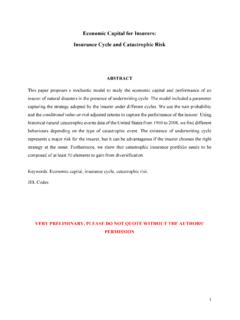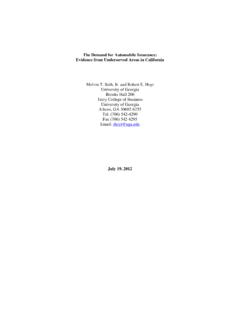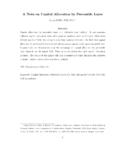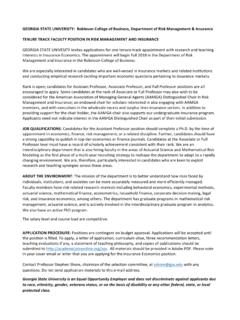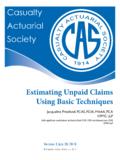Transcription of Bulk vs Case Reserves - An Issue of Manipulation
1 CASE versus BULK Reserves : AN Issue OF Manipulation Jill Bisco Candidate Department of Risk Management/Insurance, Real Estate and Legal Studies Florida State University College of Business Rovetta Business Building, Room 125A 821 Academic Way Tallahassee, FL 32306-1110 Phone: 850-644-4070 Fax: Email: Kathleen McCullough, PhD Associate Professor and State Farm Professor Department of Risk Management/Insurance, Real Estate and Legal Studies Florida State University College of Business Rovetta Business Building, Room 150 821 Academic Way Tallahassee, FL 32306-1110 Phone: Fax: Email: September 4, 20121 CASE versus BULK Reserves : AN Issue OF Manipulation ABSTRACT Prior research has not considered the allocation of loss Reserves between case and bulk Reserves when analyzing the management of loss Reserves .
2 We argue that, due to the vast flexibility in their estimation, the management of bulk Reserves will be more prevalent in contrast to the case Reserves . This study analyzes both the factors related to the use of bulk loss Reserves as well as the related question of whether their use impacts loss reserve Manipulation . Consistent with our hypotheses, we find that there are firm differences in the use of bulk Reserves as well as a significant relation between the use of bulk Reserves and earning management. Further, we find that the use of bulk Reserves and their relation to earnings management vary across lines of business. This is important for policyholders, stakeholders, and regulators as reserve Manipulation can dramatically impact insurer pricing as well as mask financial distress and alter tax payments. 2 CASE versus BULK Reserves : AN Issue OF Manipulation I. Introduction The ability of property-liability insurance companies to estimate and manage loss Reserves has been a topic of significant research over the past several decades.
3 Since claim loss Reserves are generally the largest liability on the insurer's balance sheet ( , Beaver, McNichols and Nelson, 2003), the impact of over- or under-estimation of loss Reserves has a substantial impact on the policyholders, potential claimants, regulators, other insurers, and society. While there are some norms in estimating loss Reserves , unfortunately, there appears to be no definitive definition of "reasonable" and limited guidance on what range of estimates is appropriate (Shapland, 2003). Added to the general flexibility, is the fact that Reserves are estimates with amounts built in for unforeseen developments in losses and changes in interest rates. The combination creates considerable room in what are deemed appropriate reserve estimates. This potential for variation provides insurers with the opportunity to manage their loss Reserves within reasonable limits to achieve certain financial goals.
4 Prior research indicates that insurers can use reserve manipulations to smooth income, postpone taxation, avoid reporting losses, and/or to mask insolvency concerns ( Weiss, 1985; Grace, 1990; Petroni, 1992; Kazenski, Feldhaus, and Schneider, 1992; Beaver, McNichols, and Nelson 2003; Gaver and Paterson, 2004; and Grace and Leverty, 2012). While prior research indicates that insurers manage earnings through manipulating loss Reserves , it does not describe how the insurers manage the earnings. This research expands this previous work by separating the two major types of loss Reserves ( case and bulk Reserves ) with the purpose of more clearly understanding the variation between the mix of case and bulk Reserves among insurers and whether it relates to reserve Manipulation . Specifically, we work to answer three questions. First, does the allocation between bulk and case loss Reserves relate to an insurer s financial, operational, and organization characteristics?
5 Second, does the percentage of bulk Reserves relate to the insurer s management of loss Reserves ? Finally, does the use of bulk Reserves and the relation of these Reserves to reserving error vary across different lines of business? We address these issues controlling for the fact that the insurer s decision to set the balance of bulk and case Reserves is not independent from decisions about the management of loss Reserves . We also control for the traditional factors known to impact loss reserve error. To understand the potential for differences in reserve Manipulation between case and bulk Reserves , one must first understand the difference between these two categories of loss Reserves . Case Reserves are established after a claim is submitted and are based on the details of the claim and the experience of the company with similar claims. In other words, when a claim is submitted, the insurer establishes a case reserve for that specific claim.
6 This case reserve reflects the overall expected payout for the individual claim. Case Reserves are adjusted by the insurer throughout the claims process as new information is received. Total case Reserves should reflect the amount that will be required to settle all reported claims less the amount already paid on such claims (Skurnick, 1973). Case Reserves impact policy level and customer level loss ratios. Given that loss ratios are often used in setting future premiums, management of case Reserves can directly impact a customer s premiums. This creates concern for consumers and regulators. In contrast, bulk Reserves are not designated to specific claims and are generally established based on a line of business, rather than individual claims ( a bulk amount is established for personal 3 automobile and a separate bulk amount is established for homeowners/farmowners). These Reserves are established to cover claims that have been incurred but that have not yet been reported (IBNR) to the insurer as well as an amount associated with potential unanticipated developments with case loss Accurate estimates of IBNR losses are very difficult to obtain and require some judgment (Weiss, 1985).
7 Similarly, there is considerable judgment related to estimating unanticipated future events. Due to the greater levels of uncertainty related to setting bulk Reserves , we anticipate that companies would have a greater opportunity to manage the bulk Reserves without detection from outside sources. Given the different purposes and characteristics of the case and bulk Reserves , it is likely that case and bulk Reserves will be used in different ways to achieve overall reserving goals (both related to accurately setting loss Reserves and potential management of Reserves for other purposes). This idea underlies the main research questions of whether there are significant differences in the use of case and bulk Reserves among varying demographic groups of insurers and whether there are differences between case and bulk Reserves with respect to the incentives and opportunities to manage loss Reserves . To address these questions, the first step taken is to better understand the balance between the use of case and bulk Reserves as measured by the percentage of bulk to total Reserves .
8 This is analyzed with respect to a series of firm characteristics as well as proxies for the traditional motivations for reserve management. The second stage of the analysis looks at the relation of the use of bulk versus case Reserves to loss reserving error. We do this analysis at the firm level as well as for several key lines of business ( homeowners/farmowners, personal automobile, commercial lines multi-peril, workers compensation, commercial automobile, product liability and medical malpractice liability). This allows us to determine whether firms use bulk Reserves differently based on the lines of business written or whether the strategy is uniform across the firm. This information will provide those tasked with monitoring firm s loss reserving practices with the ability to determine whether they should focus their analysis of bulk Reserves on key lines or across the firm. We find that firms with higher percentage of bulk Reserves tend to be stock companies, larger firms and those firms more focused in commercial lines.
9 Additionally, several of the traditional motives for reserve management are significantly related to the percentage of bulk Reserves including a negative relation to interest rates as well as a positive relation to tax postponement measures. With respect to the relation of overall loss reserving error and the use of bulk Reserves we find some support for the hypothesis that an increase in the use of bulk Reserves is positively related to reserving error. Also, consistent with prior literature, we find that the overall reserve error is inversely related to the overall combined ratio of the insurer and that holding companies have lower reserve errors. Firms with a less diversified mix of business ( a higher concentration in fewer lines of business) have higher reserve errors. Premium to surplus ratios and a concentration in commercial lines have a negative relation and mutual insurers tend to have a greater overall reserve error.
10 We also find weak evidence related to the relation of interest rates and reserve error. Our results are not uniform across the lines of business included in this paper. Most interestingly, we find that the percentage of bulk Reserves impacts reserve errors for long-tailed lines with lower levels of regulation such as commercial multi-peril, commercial automobile and product liability. The reserve errors associated with our short-tail line (homeowners/farmowners) and long-tail, regulated lines 1 It has been shown that the developments on reported cases could be favorable or unfavorable, increasing or decreasing Reserves (Bornhuetter and Ferguson, 1972). 4 (personal automobile, workers compensation and medical malpractice) are not significantly impacted by the percentage of bulk Reserves .



